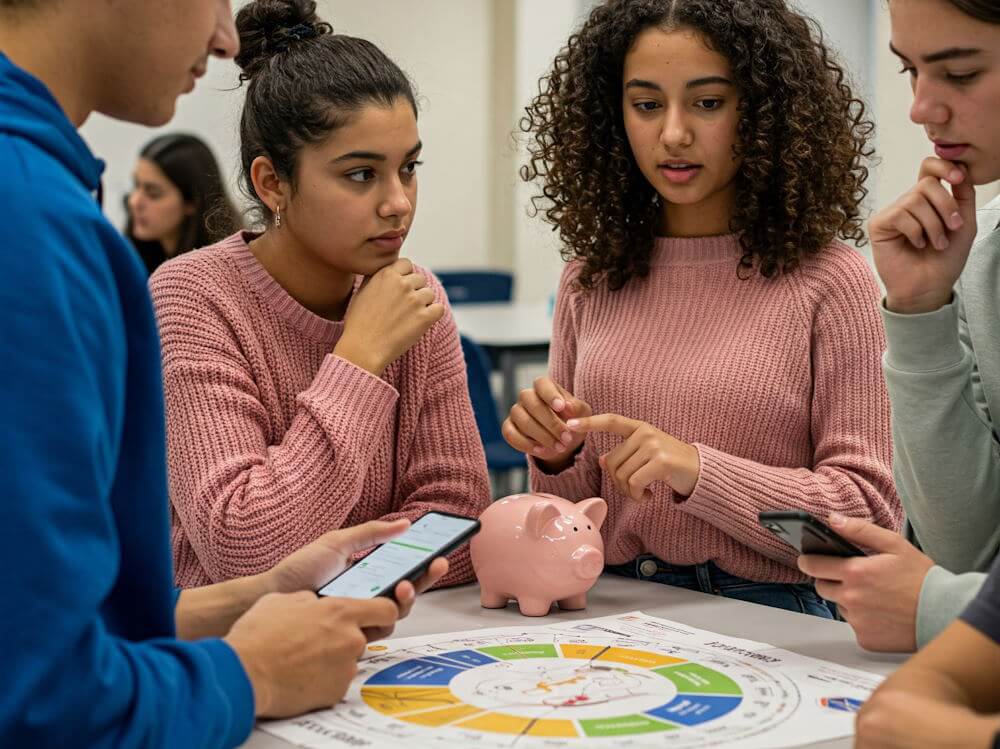Financial literacy is a crucial skill set that enables individuals, particularly teenagers, to understand and manage their finances effectively. It encompasses a variety of competencies, including budgeting, saving, investing, and understanding credit. Possessing a strong foundation in these areas equips young people with the knowledge necessary to make informed financial decisions, which can significantly impact their future well-being and economic stability.
The significance of financial literacy for teens cannot be overstated. As they transition into adulthood, they will encounter financial responsibilities ranging from managing bank accounts to understanding loans and credit cards. By cultivating financial literacy early, teenagers will be better prepared to navigate these challenges and avoid common pitfalls such as excessive debt or poor investment choices. In essence, financial literacy serves as a form of empowerment, granting young individuals the ability to take charge of their financial futures with confidence.
Moreover, being financially literate promotes a mindset of proactive decision-making. Instead of reacting to financial situations, teenagers who develop these skills can anticipate future needs and plan accordingly. For example, understanding the concept of compounding interest can motivate them to start saving early, thus enhancing their overall financial security. Furthermore, real-world applications of financial literacy are abundant, whether it be through part-time jobs, managing allowances, or even navigating student loans when pursuing higher education.
Overall, initiating the journey towards financial literacy at a young age lays the groundwork for informed and responsible financial behaviors. Teens who are educated about money management will possess the tools necessary to foster a stable economic future and achieve their long-term personal goals. As such, it is imperative for parents, educators, and policymakers to prioritize financial literacy education in order to prepare the next generation for success in an increasingly complex financial landscape.
Understanding Money Management
Money management is a crucial skill that every teenager should develop as it lays the foundation for financial independence and security in adulthood. At its core, money management involves making informed decisions regarding budgeting, saving, and spending. As teens step into a world filled with financial choices, understanding these concepts will empower them to take control of their finances.
Budgeting is the first step in effective money management. By creating a budget, teenagers can track their income and expenditures, which will help them identify where their money is going. They can start by listing all sources of income, such as allowances, part-time jobs, or money received for birthdays and special occasions. Next, they should categorize their expenses, including fixed costs like phone bills and variable costs like entertainment. This process will allow them to see their spending patterns and make adjustments as necessary.
Setting financial goals is another important aspect of money management. Teenagers should think about what they want to achieve financially. Whether it is saving for a new gadget or accumulating funds for a summer trip, having clear goals can enhance their motivation to save. They can implement the popular “50/30/20 rule,” where 50% of their income is allocated to needs, 30% to wants, and 20% to savings and debt repayment. This simple strategy helps in developing a balanced approach to spending and saving.
Finally, understanding spending habits is essential. Keeping a journal of daily expenses can help teens recognize patterns in their spending. This awareness can lead to more mindful shopping choices, steering them away from impulsive purchases. Moreover, teenagers should cultivate the habit of comparing prices and seeking out discounts, which are practical strategies to enhance their money management skills. Ultimately, mastering these principles will enable them to establish a strong financial future.
The Importance of Saving
Understanding the importance of saving money is a fundamental aspect of financial literacy that teens should grasp early on. Saving not only helps individuals prepare for unexpected emergencies but also allows them to build secure financial futures. One of the most significant strategies is the concept of an emergency fund, which acts as a financial safety net. Ideally, this fund should contain three to six months’ worth of living expenses, providing peace of mind and security in case of unforeseen circumstances such as a job loss or medical emergencies.
Teens can employ various methods to start saving. Traditional savings accounts offered by banks or credit unions serve as effective tools for this purpose. These accounts often yield interest on the deposited funds, allowing savings to grow over time. High-yield savings accounts and certificates of deposit (CDs) are also viable options that may offer better interest rates for those willing to lock away their money for a set time. Encouraging the concept of ‘paying yourself first’ can significantly impact a teen’s financial habits. This method suggests setting aside a portion of income for savings before addressing other expenses, thereby prioritizing financial health.
Moreover, it is essential to differentiate between short-term and long-term savings goals. Short-term goals, such as saving for a new gadget or a trip with friends, can generally be achieved within a year. In contrast, long-term goals may include saving for college tuition or a future car, requiring a more extended commitment. By teaching teens to plan for both immediate and future expenses, they learn the value of money management, perseverance, and the rewards that come with delayed gratification. Ultimately, developing effective saving habits early on can lead to a more secure and financially sound adulthood.
Basics of Investing
Investing is a crucial aspect of financial literacy that teens should understand early in life. At its core, investing involves putting money into assets that are expected to grow over time, as opposed to simply saving money in a bank account. While saving is about setting aside funds for future use, investing aims to increase wealth through the appreciation of assets or the generation of income. This fundamental difference highlights the importance of making informed decisions about where and how to allocate financial resources.
There are several types of investments available, each with varying levels of risk and potential return. Stocks represent ownership in a company, allowing investors to benefit from its growth and profits. Bonds, on the other hand, are loans made to corporations or governments that pay interest over time. They tend to be less risky than stocks but typically offer lower returns. Mutual funds combine the investments of many individuals to purchase stocks, bonds, or other assets, providing diversification and professional management, making them an appealing option for young investors.
An essential concept in investing is compound interest, which refers to the process where the interest earned on an investment is reinvested, generating additional earnings. This can significantly increase the overall return on investment over time, illustrating the principle of “earning interest on interest.” Teens should grasp the power of compound interest, as starting to invest early can yield substantial financial benefits in the long run.
Understanding these investment basics lays the foundation for making smart, informed financial decisions in the future. By exploring different investment vehicles and appreciating the significance of starting early, teens can build a robust financial plan that equips them for adulthood.
Understanding Credit and Debt
Understanding credit and debt is crucial for teens as they begin to navigate their financial futures. Credit refers to the ability to borrow money or access goods and services with the understanding that repayment will occur later. A key component of this is a credit score, a numerical representation of an individual’s creditworthiness. This score is influenced by various factors, including payment history, amounts owed, length of credit history, new credit, and types of credit used. It plays a significant role in a person’s financial health, impacting their ability to secure loans, receive favorable interest rates, and even influence renting agreements.
Building good credit begins with the responsible use of credit cards and loans. For instance, creating a budget that allows for regular payments on any borrowed amounts is essential. By making timely payments, a teen can gradually boost their credit score, positioning themselves for better financial opportunities in the future. Additionally, students may consider obtaining a secured credit card, where a cash deposit serves as the card’s limit. This can provide a safe avenue to develop credit without the risk of overspending.
However, misunderstanding the nature of credit can lead to significant pitfalls. For instance, excessive reliance on credit cards can result in mounting debt, often leading to higher interest rates and long-term financial strain. Real-life scenarios, such as a teen who overspends on a credit card without a repayment plan, illustrate the importance of learning to borrow responsibly. Teens should also be aware of various types of debt, such as student loans and personal loans, which can accumulate interest and influence their financial health well into adulthood. By prioritizing the understanding of credit and debt, young individuals can better prepare themselves for a financially stable future.
The Role of Technology in Personal Finance
In today’s digital age, technology plays a pivotal role in shaping personal finance management, particularly for teens who are beginning to navigate their financial landscapes. Various financial apps and tools have emerged, designed specifically to assist young individuals in managing their money more effectively. Budgeting apps, savings applications, and investment platforms are just a few examples of resources that make financial management accessible and user-friendly.
Budgeting apps, such as Mint or YNAB (You Need A Budget), enable teens to track their spending habits, set financial goals, and allocate their resources wisely. By visually categorizing expenses and income, these tools not only promote healthy spending practices but also instill a sense of accountability. Furthermore, savings apps like Qapital encourage regular saving by allowing users to set aside money automatically based on specific triggers, such as rounding up purchases or saving a certain amount each week.
Investment platforms like Robinhood or Acorns have also gained popularity among young individuals interested in entering the investment world. These applications provide beginner-friendly interfaces and educational resources that demystify the investment process, allowing teens to start building wealth early on.
However, while technology offers numerous advantages, it is crucial for teens to exercise caution. Online banking and digital wallets, such as PayPal or Venmo, provide convenience but also come with potential risks, including cybersecurity threats and overspending. It is essential for teens to learn about online safety, including the importance of securing personal information and recognizing phishing attempts.
Ultimately, technology can significantly augment personal finance education for teens. By leveraging these digital tools responsibly, young individuals can develop crucial financial skills that will serve them well into adulthood. Through diligent usage, they can achieve better financial literacy, setting the foundation for a secure financial future.
Setting Financial Goals
Establishing clear financial goals is a foundational aspect of financial literacy for teens. Setting these goals not only equips young individuals with essential skills but also allows them to align their financial decisions with their personal values and aspirations. To begin this process, it is important for teens to distinguish between short-term and long-term financial objectives.
Short-term financial goals typically span up to one year and might include saving for a new smartphone, planning for a significant event, or budgeting for a monthly entertainment allowance. Teens should be encouraged to reflect on their immediate desires and prioritize them. Utilizing tools such as budgeting apps or worksheets can help in organizing these goals effectively.
Conversely, long-term financial goals may extend beyond one year and involve more significant milestones such as saving for college tuition, purchasing a vehicle, or even investing for the future. For long-term goals, it is critical for teens to think strategically about what they want to achieve. They should ask themselves questions regarding their aspirations and how their financial decisions can help realize those ambitions.
When identifying these goals, specificity and realism remain key. Goals should be defined with clear parameters, such as the exact amount of money targeted for savings and the timeline for achieving these objectives. To illustrate this point, a teen aiming to save $500 for a summer trip within six months is more likely to succeed than someone who simply states they want to save money.
Additionally, sharing motivational anecdotes can further galvanize teens toward goal setting. For example, a peer who successfully saved for a dream laptop through part-time work can inspire others to take similar steps. By integrating these structured approaches, teens can not only set financial goals but also develop the critical thinking skills necessary for navigating their financial futures successfully.
Navigating Financial Independence
The journey to financial independence for teens marks a significant transitional phase in their lives. It is essential that young individuals grasp the key elements involved in living on their own, including the various expenses they will encounter. Understanding housing costs, utilities, food expenses, and transportation requirements is fundamental as they move toward self-sufficiency. Living independently entails a budget that allows them to manage these costs effectively, distinguishing between essential needs and discretionary wants. This skill is paramount, as it will assist them in making informed financial decisions that can greatly impact their future.
Furthermore, the importance of part-time jobs and internships should not be underestimated. Engaging in employment not only generates income, but also helps teens cultivate valuable skills and gain realistic insights into the working world. These experiences should be embraced as opportunities for learning, as they provide a practical context for understanding work ethics and professional responsibilities. Additionally, exploring entrepreneurship can be a rewarding avenue for financially savvy teens, allowing them to set their own terms while developing a sense of initiative and responsibility.
To achieve financial independence responsibly, it’s vital for teens to develop a financial plan that suits their lifestyle and goals. This includes tracking income and expenses meticulously, understanding the importance of savings, and setting short- and long-term financial goals. Seeking guidance from financial literacy resources, parents, or educators can also be incredibly beneficial as they navigate these decisions. Ultimately, by equipping themselves with the right knowledge and tools, teenagers can smoothly transition into adulthood with a firm grasp of financial independence—ensuring they are poised for future success.
Resources for Continued Learning
To foster an understanding of financial literacy among teens, a variety of resources are available that can serve as valuable tools for continued education. Books, online platforms, and community workshops can provide comprehensive insights and practical knowledge about managing finances effectively.
Starting with books, titles such as “Rich Dad Poor Dad for Teens” by Robert Kiyosaki present concepts of investing and money management in an engaging manner. Additionally, “The Teen Investor” by Emmanuel Modu offers a straightforward approach to understanding the stock market and investment strategies. These books can spark interest in young readers, motivating them to further explore financial topics.
Websites like Next Gen Personal Finance (NGPF) offer free resources, including lesson plans, games, and articles tailored for teenagers. Similarly, Khan Academy provides free courses in personal finance that break down complex subjects into digestible lessons. These platforms empower teens to learn at their own pace and reinforce their understanding of financial concepts.
Podcasts such as “Teen Money” and “The Dave Ramsey Show” (with family-oriented episodes) address various aspects of personal finance, presenting them in an engaging auditory format. Listening to expert advice and real-life experiences can further enhance a teen’s financial literacy journey.
Lastly, engaging workshops and community classes, often provided by local libraries or community centers, can offer hands-on learning experiences. These programs cover a range of topics, from budgeting to investing, facilitating group discussions that encourage interactive learning. By exploring these resources, teens can continue to grow their financial knowledge and develop skills necessary for managing their finances wisely in the future.




